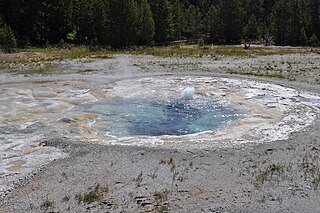
A geyser is a spring characterized by intermittent discharge of water ejected turbulently and accompanied by steam. As a fairly rare phenomenon, the formation of geysers is due to particular hydrogeological conditions that exist only in a few places on Earth. Generally all geyser field sites are located near active volcanic areas, and the geyser effect is due to the proximity of magma. Generally, surface water works its way down to an average depth of around 2,000 metres (6,600 ft) where it contacts hot rocks. The resultant boiling of the pressurized water results in the geyser effect of hot water and steam spraying out of the geyser's surface vent.
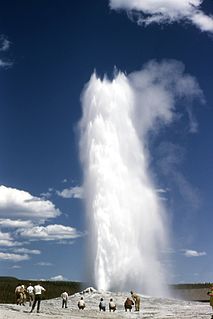
Old Faithful is a cone geyser located in Yellowstone National Park in Wyoming, United States. It was named in 1870 during the Washburn-Langford-Doane Expedition and was the first geyser in the park to receive a name. It is a highly predictable geothermal feature, and has erupted every 44 to 125 minutes since 2000. The geyser and the nearby Old Faithful Inn are part of the Old Faithful Historic District.

Grand Geyser is a fountain geyser in the Upper Geyser Basin of Yellowstone National Park in the United States. It is the tallest predictable geyser known. It was named by Dr. F.V. Hayden in 1871.
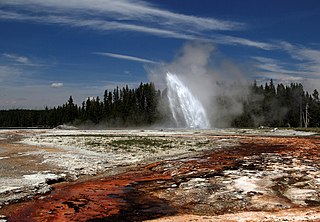
Daisy Geyser is a geyser in the Upper Geyser Basin of Yellowstone National Park in the United States.

Splendid Geyser is a geyser in the Upper Geyser Basin of Yellowstone National Park in the United States.

Brilliant Pool is a hot spring in the Upper Geyser Basin of Yellowstone National Park in the United States.
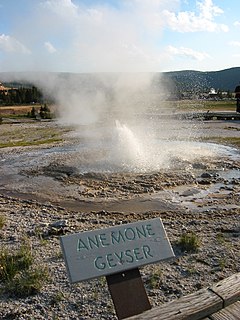
Anemone Geyser is a geyser in the Upper Geyser Basin of Yellowstone National Park in the United States. Anemone is actually two closely related geysers. The larger of the two is known as Big or North Anemone while the smaller is known as Little or South Anemone. The two geysers were named after the anemone flower by the Hague Party in 1904. Both vents have a pale yellow color and shape similar to the flower.
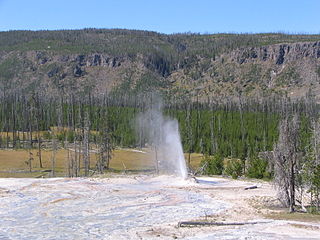
Atomizer Geyser is a cone geyser in the Upper Geyser Basin of Yellowstone National Park in the United States. Atomizer Geyser is part of the Old Road Group which includes Artemisia Geyser, a short distance down the Firehole River from Old Faithful and other major Upper Basin geysers. The geyser is named for a fine mist resembling the spray from an atomizer that is ejected during major eruptions.
Dilemma Geyser is a geyser in the Lower Geyser Basin of Yellowstone National Park in the United States. It is part of the Pink Cone complex. Other geysers in this group are Bead Geyser, Box Spring, Labial Geyser, Labial's Satellite Geyser, Narcissus Geyser, Pink Geyser, and Pink Cone Geyser.

Pump Geyser is a cone geyser located in the Upper Geyser Basin of Yellowstone National Park. It is in the Geyser Hill Complex which includes Aurum Geyser, Beehive Geyser, Big Cub Geyser. Doublet Pool, Giantess Geyser and Lion Geyser, among others.

Beehive Geyser is a geyser in the Upper Geyser Basin of Yellowstone National Park in the United States. The 4-foot (1.2 m) tall cone resembles a beehive. Beehive's Indicator is a small, jagged cone-type geyser located about 10 feet (3.0 m) from Beehive.

Jet Geyser is a geyser in the Lower Geyser Basin of Yellowstone National Park in the United States. Jet Geyser is in the Fountain Group that includes Fountain Geyser, Morning Geyser, Red Spouter and Silex Spring.
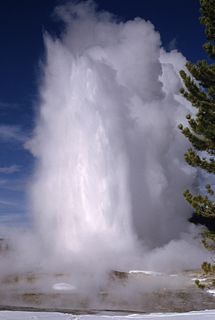
Giant Geyser is a cone-type geyser in the Upper Geyser Basin of Yellowstone National Park in the United States. Giant Geyser is the namesake for the Giant Group of geysers, which, on its platform, includes Bijou Geyser, Catfish Geyser, and Mastiff Geyser. Giant Geyser's Platform, a raised stone structure incorporating all these geysers. Giant is notable for its spectacular, but sporadic eruptions, as well as for its very large cone of geyserite, which stands about 12 feet tall.

Economic Geyser is a geyser in the Upper Geyser Basin of Yellowstone National Park in the United States.
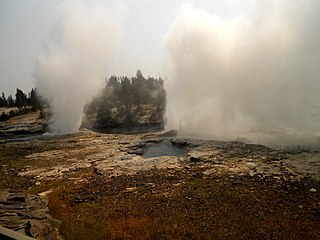
Fan and Mortar Geysers are two geysers in the Upper Geyser Basin in Yellowstone National Park. For the past several decades, they have erupted in concert with one another and are generally talked about together. The records detailing these geysers' known eruptive history shows that they have been infrequent and irregular performers.

Grotto Geyser is a fountain-type geyser located in the Upper Geyser Basin in Yellowstone National Park in the United States. Grotto Geyser is the namesake for the group of geysers that includes Grotto Fountain Geyser, South Grotto Fountain Geyser, Indicator Spring, Spa Geyser, and Rocket Geyser.

Ear Spring is a hot spring in the Upper Geyser Basin of Yellowstone National Park in the United States. Located close to Old Faithful, on rare occasions Ear Spring will erupt as a geyser, and can shoot rocks and debris as well as water more than 25 feet (7.6 m) for a few minutes. On September 15, 2018, Ear Spring was seen on the National Park Service webcam at Old Faithful erupting for a minute and reached heights of 20 to 30 ft. This was the largest eruption the pool may have had since 1957. The eruption tossed small rocks out and the heated water killed the surrounding bacterial mats that normally thrive in less heated conditions. Likely related to the eruption of Ear Spring, a new thermal feature opened up under the pedestrian boardwalk near Pump Geyser which resulted in the National Park Service temporarily closing off the boardwalk. This new thermal feature was spouting water the night of September 18-19, 2018. Additionally, Doublet Pool and North Goggles Geyser have both been more active in the period immediately after the rare eruption of Ear Spring.
Semi-Centennial Geyser is located just north of Roaring Mountain in Yellowstone National Park in the U.S. state of Wyoming. Situated next to the Grand Loop Road, the geyser was first noticed when it had a few small eruptions in 1919. A few years later at 6:40am on August 14, 1922 the geyser erupted in the first of a series of increasingly violent eruptions, which by the afternoon on the same day reports stated that the ejected water was exceeding 300 feet (91 m) in height. By the evening of the 14th, the geyser had scattered debris and rocks a distance of 450 ft (140 m) from the crater. Short lived, Semi-Centennial Geyser has been quiet since and a small pool of water now sits where the geyser erupted. As the geyser showed its biggest activity in 1922, the 50th anniversary of the establishment of Yellowstone National Park in 1872, it was accorded the name of Semi-Centennial.
